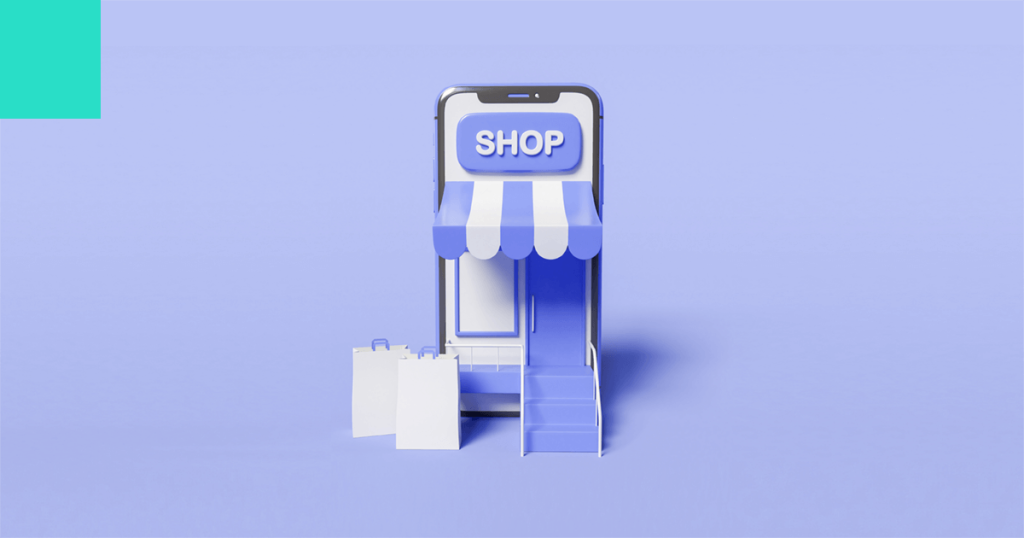When people start an eCommerce business, the first problem they have is a lack of traffic and sales. The second problem they stumble upon is the absence of eCommerce strategies that would help move things forward.
So, what eCommerce strategies do you need to apply to succeed?
In this post, you will get familiar with six powerful eCommerce strategies that will help you out.
Let's cut to the chase!
The Essence of Ecommerce Marketing
Ecommerce marketing stands for using different marketing strategies that help drive awareness and attract more potential customers to an online store.
As a rule, eCommerce marketing involves inbound (digital) marketing strategies mostly. These strategies are all related to improving the overall performance of your eCommerce store. Starting from a website structure, UX design, content, SEO, ending with advertising, and other aspects that aim to move potential leads down the marketing funnel.
However, now you can see people use outbound marketing strategies like speaking at conferences, print advertising, billboards, etc.
This post will reveal eCommerce digital marketing strategies only.
Let's review them.
1. Content Marketing Strategy
Content marketing is an excellent way to suggest your product to the audience gently. However, there is a condition you must follow - create educational content that would teach potential customers how to solve their issues.
For instance, a well-known brand Philips created a tutorial on how to trim a beard. As you can see, the company promotes its trimmer within the post.
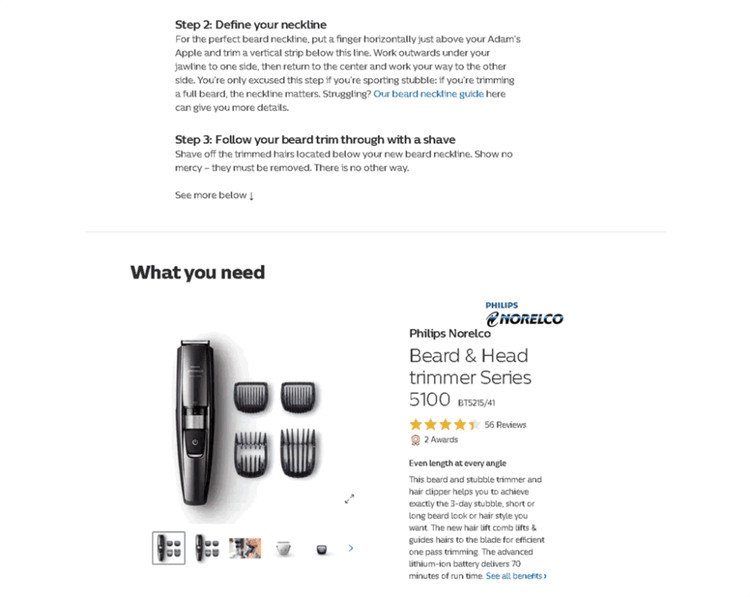
So, how to start promoting your eCommerce products using content marketing.
Focus on the Topics with Search Traffic Potential
First of all, lots of business owners focus their blogging on covering content that is not related to their target audience. Obviously, you will get a short spike of traffic. Unfortunately, this traffic won't help you in getting more potential leads.
Why?
Simply because this traffic is not targeted. What's more important, after a "spike of hope" goes a "flatline of nope" that looks like this.

Instead, if you focus on the topics that are related to your target audience, traffic will grow organically.
But how to find these topics?
You can use Google Keyword Planner tool or Ahrefs' Keywords Explorer tool. This tool suggests way more keyword ideas to choose from. You should focus your attention on the "Phrase match" report.
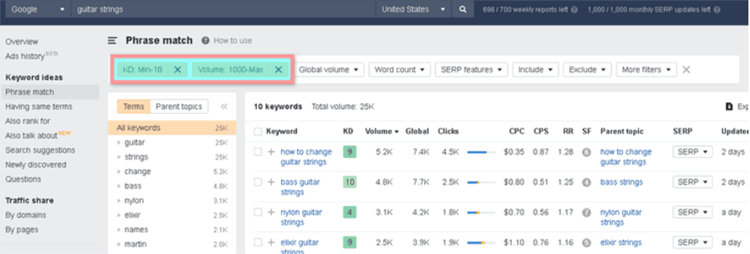
Since the report can suggest a huge number of keyword phrase ideas, you can use filters like "Volume" and "KD" to narrow down the results to the most promising ones.
Afterwards, brainstorm topic ideas based on the keyword phrase findings and start creating content. When you create content, try to make it diversified. It means you should apply different forms of content.
In other words, repurpose your content into visuals like infographics, flowcharts, presentations, etc. But keep in mind that this content creating approach demands using additional tools, flowchart maker tool as an example.
Create Video Content on YouTube
A well-known music equipment brand Dunlop has a YouTube channel with 127K subscribers.

Plus, this channel ranks for relevant keywords.

As you can see, by creating video content on YouTube you can not just post some explainer videos but share links to your online store as well.
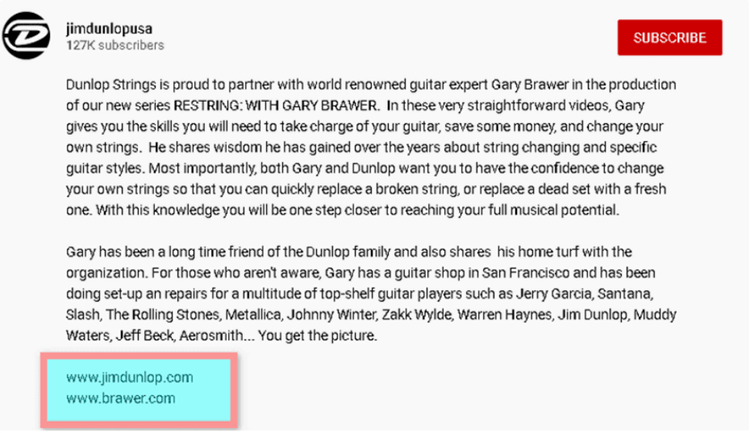
To help you succeed with creating high-quality and engaging content for your online store, you can follow these pieces of advice:
a) Pay attention to audio and video quality
b) Try to teach your audience and solve the issues people have
c) Create a video publishing schedule and stick to it
d) Be honest with your audience, don't promote or advise something you don't have any experience with
2. SEO Strategy
SEO is all about optimizing your eCommerce store pages to make them rank on Google. In return, you will get traffic to your website and sales.
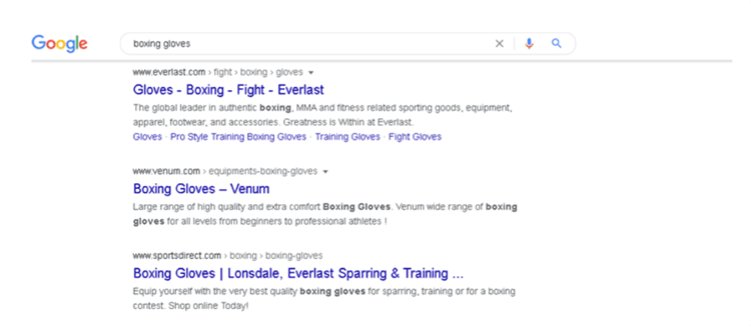
How to start optimizing your online store?
Firstly, you should focus on optimizing product and category pages. You can do this by following these steps:
a) Start with keyword research (Identify those search queries that your potential customers type on Google)
b) Make sure you identified search intent (Search queries must align with product or category pages in the SERP)
c) Do on-page SEO (Optimize title tag, description, H1, URL, and product description)
d) Link building. Build backlinks to your product pages (however, it is quite difficult)
3. Email Marketing Strategy
Email marketing starts with building an email list. The next step is to make your content marketing efforts work and generate traffic to your online store.
When people start coming to your website through content, your task is to make them sign up to your email list. As a rule, people won't subscribe without a good reason for this. Hence, your aim is to offer them something in return.
It could be some free content (eBook), discounts, whatever would work. Right after people start signing up to your email list, you should create an onboarding sequence. The purpose of this sequence is to keep people engaged with your online shop in general. Introduce yourself, share some useful content, some new product updates.
You must follow one major principle of email marketing - building a tight connection with the customers. If you can make your customers engaged with what you do and what you offer, they will return to your online store again. Which means more sales for you.
4. Google Ads Strategy
If you want your products to be shown on the first page of Google without any SEO efforts, you should use Google ads. The best side of using advertising on Google is that you will get traffic in a blink of an eye. The downside of Google ads is that it costs you money.
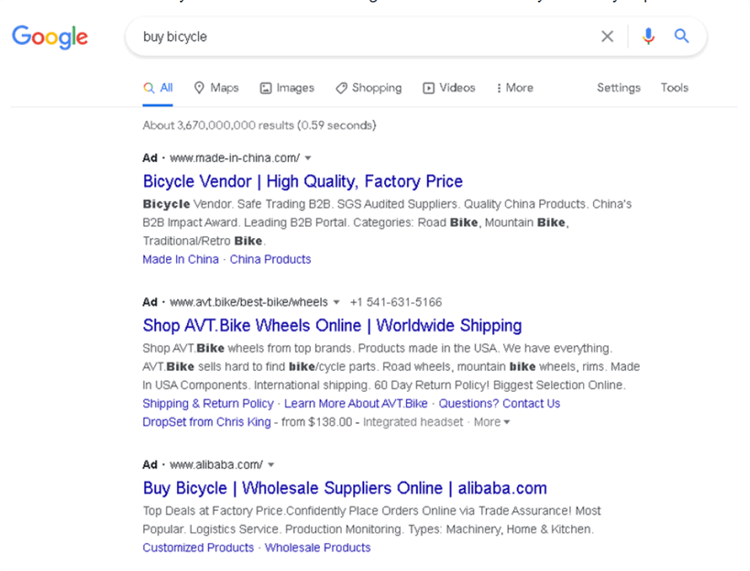
Google ads are divided into:
Search ads
Display retargeting
Google shopping
Let's review each of them:
1) Search Ads
You've seen lots of times search ads appear on Google when you type a particular keyword. If you want your products to be listed in the form of ads, you must identify what keywords you should target.
How to do this and choose those keywords that would be related to your online store business?
It is achievable by exploring keywords your competitors are bidding on. Keep in mind that your competitors won't be spending their money on targeting those keywords that don't bring them sales.
Hence, follow this path by yourself. Just take these keywords for your search ads as well.
How to find the keywords your competitors are bidding on?
You can find these keywords by reviewing "PPC keywords" in Site Explorer tool.
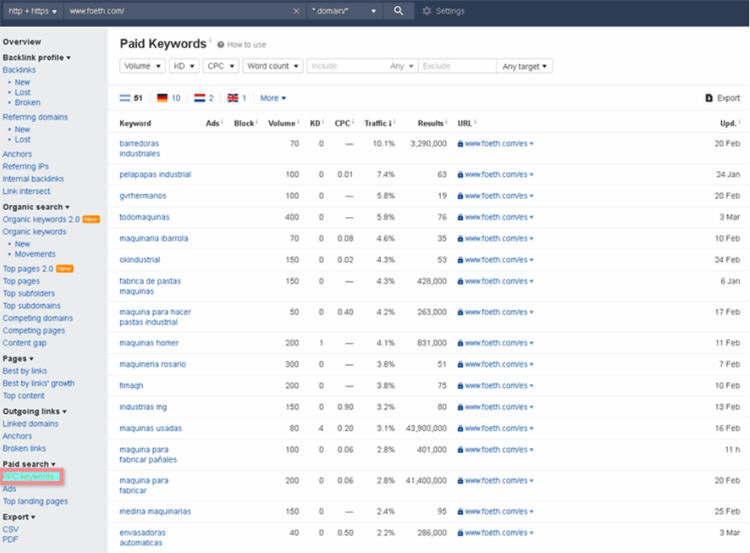
This report provides the keywords your competitors are bidding on along with the landing pages that get traffic, and the ad copy used.
2) Display Retargeting
Retargeting is a very useful form of advertising technically and here is why. It allows you to target those people who have visited your website previously and left it eventually.
The goal of this retargeting advertising is to remind people about your online store and visit it again and make a purchase in perspective.
The scheme of working this retargeting advertising is simple.
First of all, you must install a pixel code on your website (copy-pasting). This code tells Google when some person visits your online store. Finally, if this person visits some other online stores shown by Google ads, Google will retarget this person and show your ad.
3) Google Shopping Ads
This form of advertising you've seen as well.
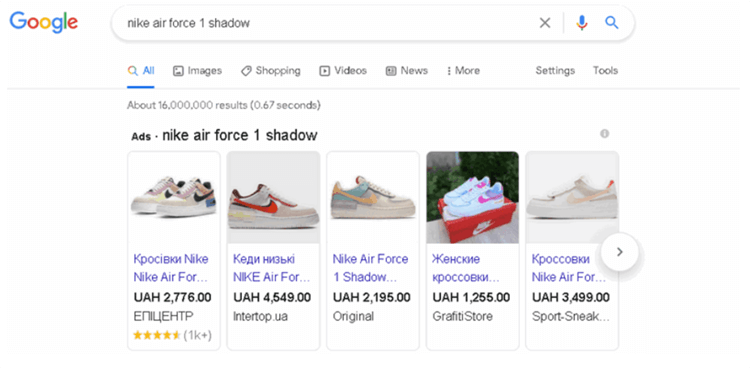
Source: Google
It should be stated that Google shopping ads are quite compelling. They appear above organic results for commercial queries and you can include images.
To conclude, using Google ads is one of the most straightforward approaches to generate traffic to your online store and attract more potential customers.
Some experts believe that some forms of Google advertising can be considered as an unethical way to increase traffic. The other eCommerce specialists don't see anything wrong with this approach. The truth is that Google ads can give you the results you're expecting to get.
5. Social Ads Strategy
Social ads would be an ideal choice for those who run an eCommerce store selling niche products.
Why?
Because social ads don't demand you to invest tons of money. Moreover, if you measure ROAS (return on ad spend), you would be able to control the money spending process easily.
How?
By seeing the increasing number of sales you generate via social ads. If the numbers are poor, you can stop paying for the ads.
Now, let's review some of the social ads you can use in the practice.
Instagram Social Ads
When you're running social ads on Instagram, you should not be afraid of experimenting. In other words, you must identify which ad would work for your eCommerce store the best in terms of ROAS.
Here are some pieces of advice that will help you make your best with Instagram ads.
Try to make a copy of the ad including one question at least
Place ads in feed or stories
Experiment with images vs. videos in the ads
Show the ads with specific products in certain regions of the world (location targeting)
Facebook Social Ads
Advertising on Facebook is believed to be the first social type of ads that people tend to run. Thus, there are plenty of guides that cover this topic in detail.
In a nutshell, you should follow these few suggestions while running Facebook social ads.
Use dynamic product ads
Use multi-product ads
Install conversion tracking pixel
Run general retargeting campaigns
Find new customers with lookalike audiences
Use ads to communicate a brand story
Strengthen existing customer relationships with custom audiences
6. Affiliate Marketing Strategy
It is a well-known fact that many B2C and B2B companies create affiliate programs to increase their revenue. And they show good progress with their affiliate marketing activities so far.
What is the essence of affiliate marketing?
Affiliate marketing is based on paying a commission to other partners who sell your products.
Ecommerce stores follow this strategy just like the rest of the companies across different niches.
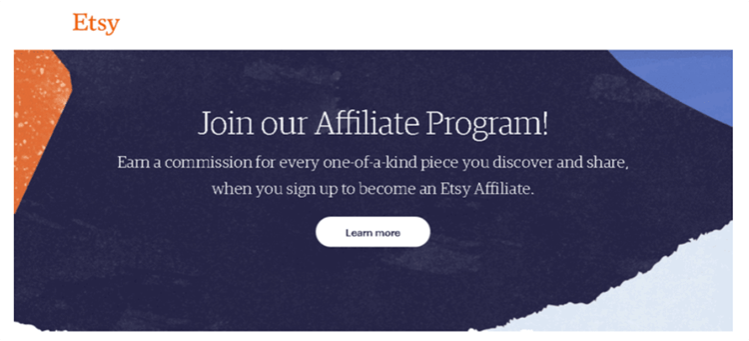
Source: Etsy
Affiliate marketing for your eCommerce store works in four stages:
Affiliate partners promote your products
A potential customer clicks an affiliate link and buy your product
This process of purchasing is tracked by pixel
You pay an agreed commission to your affiliate partners
Sounds simple, right?
Yes, but if your eCommerce store has just been launched, you will have some difficulties with finding your potential partners.
How to move the needle in this case?
Go to Google and type this command "top [your niche] influencers/bloggers", and you will get various curated lists where you will be able to find the candidates for building an affiliate partnership.
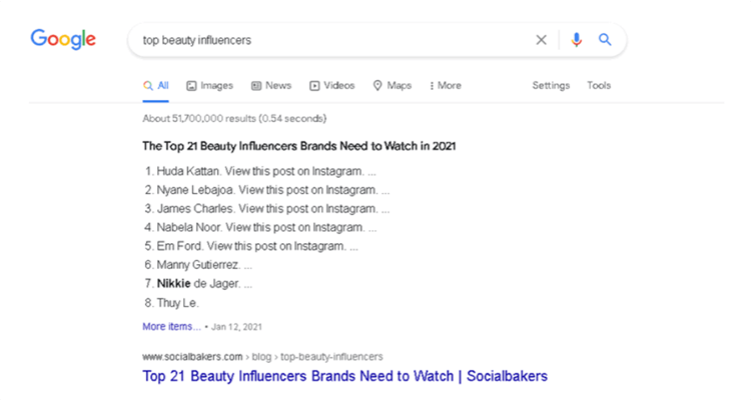
Source: Google Search
The next challenge is to persuade potential affiliates to build a partnership with you. Abide by these three rules:
You must offer a good product (literally)
Try to make the process of promoting your product easy for your partners
Offer a solid commission
Remember that affiliate marketing is about building relationships on a win-win basis. Hence, when you start working with the affiliates, you must take care of them. In return, you will get more sales.
To understand all the pitfalls of affiliate marketing for your eCommerce marketing, you must know the principles of B2B and B2C marketing strategies as well. So, don't shy away from reading some B2B marketing guide that will help you stress a topic.
Conclusion
Ecommerce marketing strategies work for a hundred percent. It is a fact.
But if you have just launched your eCommerce store, you should better choose one strategy from suggested above. Don't invest your budget, time, and efforts trying to implement all strategies.
How to make the right choice?
Look at your target audience - who are the people you're trying to sell your product and where you can find them.
By knowing this information you will be able to choose the strategy that would work for you.
When you see the first results, you can add more strategies to your arsenal.
